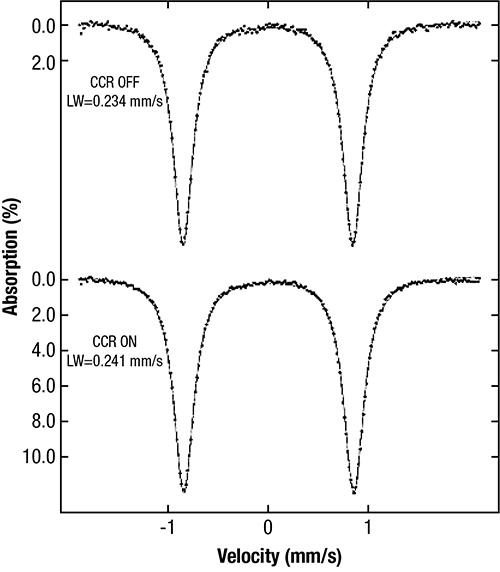Applications | Mössbauer spectroscopy
Lake Shore has several solutions available for Mössbauer spectroscopy. Mossbauer Complete Cryo and Mossbauer Complete RT are turnkey systems, or you can use the standalone CCS-800-205 cryostat.
Mossbauer Complete Cryo and the CCS-800-205 cryostat come with a special vibration isolation stand for easy laboratory integration. They locate the sample in exchange gas for uniform sample cooling. Powder samples, or other samples that are difficult to thermally anchor, are evenly cooled because the system does not rely on the thermal conductivity of the sample for cooling. This approach has the added advantage of fast sample exchange.
 Shown
are Fe57 Mössbauer spectra (dots) of a 25 µm iron metal foil at 298 with the CCR off and on. The velocity scan of ±2 mm/s covers only the innermost lines of the iron metal sextet. Also shown
are least squares fits (lines) of a symmetric quadrupole pair with Lorentzian line shapes to each spectrum. The results of the fits were linewidth estimates of 0.234 mm/s with the CCR off and 0.241 mm/s with the CCR on. The uncertainty
in the line width estimates due to the counting statistics is ±0.002 mm/s.
Shown
are Fe57 Mössbauer spectra (dots) of a 25 µm iron metal foil at 298 with the CCR off and on. The velocity scan of ±2 mm/s covers only the innermost lines of the iron metal sextet. Also shown
are least squares fits (lines) of a symmetric quadrupole pair with Lorentzian line shapes to each spectrum. The results of the fits were linewidth estimates of 0.234 mm/s with the CCR off and 0.241 mm/s with the CCR on. The uncertainty
in the line width estimates due to the counting statistics is ±0.002 mm/s.
NOTE: Data provided by Science Engineering & Education Co. (SEE Co. — formerly Web Research Co.). Special thanks to Professor Darby Dyar, Mount Holyoke College.
Contact us today for details of how our systems can be integrated into your laboratory.
What is Mössbauer spectroscopy used for, and when is cryogenic cooling required?
Mössbauer spectroscopy enables physicists and material researchers to study material properties at the atomic level. Studies can involve the magnetic property investigation, phase transition analysis, or measuring minute energy levels and interactions within electronic materials. Because certain materials and device phenomena can be best observed at very low temperatures, integrating a Mossbauer spectrometer into a cryogenic environment is often required for some experiments. Additionally, cooling samples to cryogenic temperatures helps to ensure stability for measurements performed over time. Cryostats like Lake Shore’s top-loading CCS-800 with vibration isolation are commonly used for cryogenic cooling in Mössbauer spectroscopy due to their uniform cooling of samples without introducing significant levels of vibration, which helps maintain the integrity of spectral lines and prevents broadening of those lines to help ensure more precise measurements. In addition, they help to ensure thermal stability, which can be crucial. Even minor fluctuations can significantly affect sensitive Mossbauer spectroscopy experiments.


